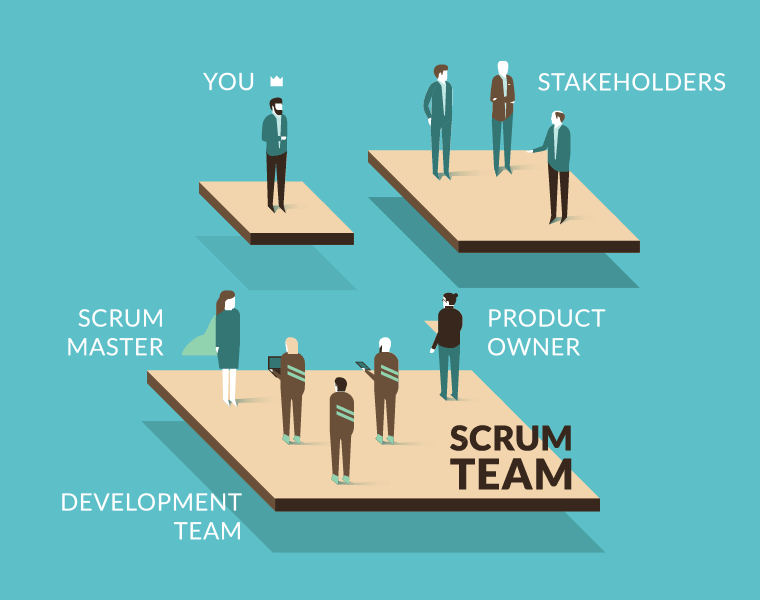Product owners have an important role to play in agile teams. After all, they are the only people who are responsible for the standard of the team’s performance. But it’s also a highly visible position as they are also responsible for maintaining the product backlog and making sure that the team is up to date.
It can be a difficult role as often in large enterprises, the products are not clearly defined. Additionally, they may not have clearly defined roles or a central decision owner. This can be the result of several projects (that are highly complex in nature) extending across a variety of departments, teams, and organizations.
But the final responsibility of getting the job done effectively falls directly onto one person. As a result, it can be a complicated task when it comes to managing all stakeholders and product prioritization.
If you're product owner and this scenario sounds familiar, the best approach is to start perceiving yourself as a member of your or your service provider's agile team. This means that you have to stop thinking of yourself as an external product manager and start working closely with developers to ensure that they clearly understand the requirements before they even start working on the build.
If you're a business owner, your perception of your product owner should be as shown in the gif below:

You have to take it a step further and always be on call to answer questions. While this may sound obvious, a lot of product managers often neglect this dimension to their role. Instead, they solely focus on their other responsibilities like:
- Communicating strategy to stakeholders
- Managing budgets and resources
- Developing product roadmaps
- Incorporating user feedback and competitive intelligence
While these factors also play an important role in the development process, you simply can’t neglect your agile development team. If you don’t function as a member of the development team, you won’t communicate with them as much as needed. This, in turn, will result in less input during the build with a higher chance of the project drifting away from your original strategic vision.
What are the Characteristics of a Good Product Owner?
Scrum Alliance says a good Product Owner is one who:
- Represents business and acts as the client's face for development team
- Has product vision
- Makes responsible decisions
- Influences releases
- Provides project visibility to business leadership
- Motivates team to perform to its utmost potential
- Maximizes business value
Individuals who are successful in this role act as part of the development team (so it’s a lot more than writing specs and iteration planning). Right from the early stages and throughout the product life cycle, you have to be actively involved with the team.
So whether it’s meetings, discussions, or demonstrations, be there and make yourself available. Before going into a sprint, review each story and make a decision with the help of a mock-up.
However, you might start feeling like you’re over-communicating with your development team. This is a good sign, so don’t let that stop you from engaging with them frequently. But if you’re falling short, you will start noticing that your product specs are often misunderstood. If you were part of a cohesive team that’s strategically aligned, this will be a rare occurrence (if it even happens at all).
The primary advantage of an agile environment is the tight feedback loop for both product owners and developers. Especially in sprint reviews, you will have plenty of opportunities to provide directional feedback on the product development while receiving regular updates on the progress made.
Why do Product Owners Fail?
If you think that just embedding yourself in an agile team and engaging with them is all you need to be successful, you would be wrong. This is because the role is really time-consuming and sometimes intimidating.
Attending and participating in sprint planning meetings, answering questions, and reviewing mockups can all take a huge chunk of your time. Further, preparing developers before placing that story for sprint can also get drawn out if it’s not clearly understood. The product owner also needs to find time for all this while staying on top of the following responsibilities:
- Maintain backlog visibility
- Make decisions
- Define the vision and product features
- Prioritize user stories
- Groom the product backlog
- Accept of reject results
- Plan for releases
- Engage with all stakeholders
- Prepare for the product launch
Check out what to consider before launching a new product!
Sometimes the role can feel intimidating if the product owner isn’t from a technological background. But any apprehensions or fear shouldn’t hold you back as it’s completely fine to tell a developer that you don’t understand something. They will be more than happy to explain it in a simpler manner that can be easily understood.
Being part of the team can also help break down all communication barriers as both product owners and developers will learn how to communicate effectively with each other.
If you get this right, it will help seamlessly bridge the gap between product management and engineering to ensure that great products are delivered on time and according to specs.
Featured image: mountaingoatsoftware.com









